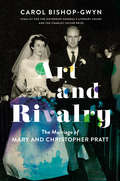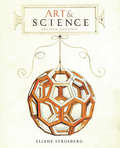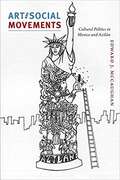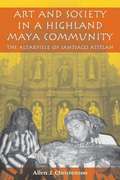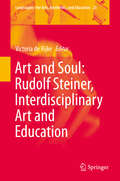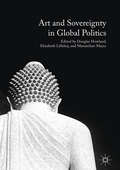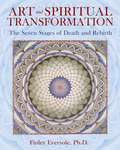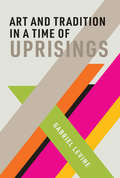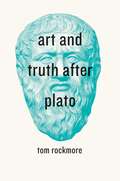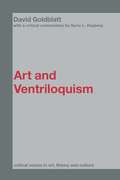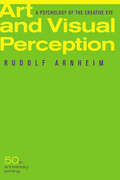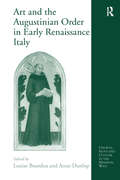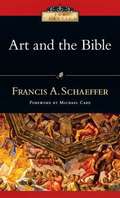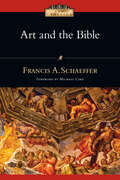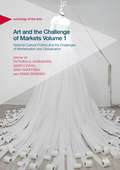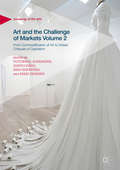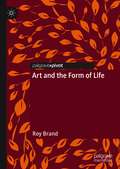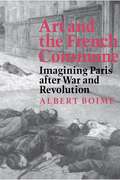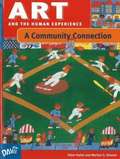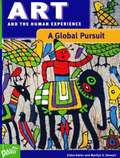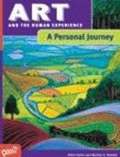- Table View
- List View
Art and Rivalry: The Marriage of Mary and Christopher Pratt
by Carol Bishop-GwynThe unauthorized biography of Canada's most famous artist couple and the rivalry that drove them.She painted as if with pure light, radiant colours making quotidian kitchen scenes come alive with sublimated drama. He painted like clockwork, each stroke precise and measured with exquisite care, leaving no angle unchecked and no subtlety of tone unattended. Some would say Mary Pratt was fire and Christopher, ice. And yet Newfoundland's Frida Kahlo and Diego Rivera (or Jackson Pollack and Lee Krasner...) presented their marriage as a portrait of harmony and balance. But balance off the canvas rarely makes great art, and the Pratts' art was spectacular. As a youth at Mount Allison University in New Brunswick, Mary pursued her future husband, a prodigious art talent, and supported his determination to study painting instead of medicine. They married and removed themselves to a Newfoundland outport where his painting alone provided the means to raise a family. But as Mary's own talents became evident and she sought her own hours at the easel, when not raising their four children, and as rumours of Christopher's affair with a young model spread, the Pratts' harmonious exterior slowly cracked, to scandal in Newfoundland and fascination across the country. A marriage ended, and gave way to a furious competition for dominance in Canadian art.
Art and Science
by Eliane StrosbergToday, art and science are often defined in opposition to each other: one involves the creation of individual aesthetic objects, and the other the discovery of general laws of nature. Throughout human history, however, the boundaries have been less clearly drawn: knowledge and artifacts have often issued from the same source, the head and hands of the artisan. And artists and scientists have always been linked, on a fundamental level, by their reliance on creative thinking.Art and Science is the only book to survey the vital relationship between these two fields of endeavor in its full scope, from prehistory to the present day. Individual chapters explore how science has shaped architecture in every culture and civilization; how mathematical principles and materials science have underpinned the decorative arts; how the psychology of perception has spurred the development of painting; how graphic design and illustration have evolved in tandem with methods of scientific research; and how breakthroughs in the physical sciences have transformed the performing arts. Some 265 illustrations, ranging from masterworks by Dürer and Leonardo to the dazzling vistas revealed by fractal geometry, complement the wide-ranging text.This new edition of Art and Science has been updated to cover the ongoing convergence of art and technology in the digital age, a convergence that has led to the emergence of a new type of creator, the "cultural explorer" whose hybrid artworks defy all traditional categorization. It will make thought-provoking reading for students and teachers, workers in creative and technical fields, and anyone who is curious about the history of human achievement.
Art and Social Movements: Cultural Politics in Mexico and Aztlán
by Edward J. McCaughanArt and Social Movements offers a comparative, cross-border analysis of the role of visual artists in three social movements from the late 1960s through the early 1990s: the 1968 student movement and related activist art collectives in Mexico City, a Zapotec indigenous struggle in Oaxaca, and the Chicano movement in California. Based on extensive archival research and interviews, Edward J. McCaughan explores how artists helped to shape the identities and visions of a generation of Mexican and Chicano activists by creating new visual discourses. <p><p> McCaughan argues that the social power of activist artists emanates from their ability to provoke people to see, think, and act in innovative ways. Artists, he claims, help to create visual languages and spaces through which activists can imagine and perform new collective identities and forms of meaningful citizenship. The artists' work that he discusses remains vital today—in movements demanding fuller democratic rights and social justice for working people, women, ethnic communities, immigrants, and sexual minorities throughout Mexico and the United States. Integrating insights from scholarship on the cultural politics of representation with structural analyses of specific historical contexts, McCaughan expands our understanding of social movements.
Art and Society in a Highland Maya Community
by Allen J. Christenson"Allen J. Christenson offers us in this wonderful book a testimony to contemporary Maya artistic creativity in the shadow of civil war, natural disaster, and rampant modernization. Trained in art history and thoroughly acquainted with the historical and modern ethnography of the Maya area, Christenson chronicles in this beautifully illustrated work the reconstruction of the central altarpiece of the Maya Church of Tz'utujil-speaking Santiago Atitlán, Guatemala. The much-loved colonial-era shrine collapsed after a series of destructive earthquakes in the twentieth century. Christenson's close friendship with the Chávez brothers, the native Maya artists who reconstructed the shrine in close consultation with village elders, enables him to provide detailed exegesis of how this complex work of art translates into material form the theology and cosmology of the traditional Tz'utujil Maya. With the author's guidance, we are taught to see this remarkable work of art as the Maya Christian cosmogram that it is. Although it has the triptych form of a conventional Catholic altarpiece, its iconography reveals a profoundly Maya narrative, replete with sacred mountains and life-giving caves, with the whole articulated by a central axis mundi motif in the form of a sacred tree or maize plant (ambiguity intended) that is reminiscent of well-known ancient Maya ideas. Through Christenson's focused analysis of the iconography of this shrine, we are able to see and understand almost firsthand how the modern Maya people of Santiago Atitlán have remembered the imagined universe of their ancestors and placed upon this sacred framework their received truths in time present. "--Gary H. Gossen, Distinguished Professor Emeritus of Anthropology and Latin American Studies, University at Albany, SUNY
Art and Soul: Rudolf Steiner, Interdisciplinary Art and Education (Landscapes: the Arts, Aesthetics, and Education #25)
by Victoria De RijkeThis book brings together Steiner's philosophical, biodynamic and cultural contributions to education, where 'spirit' and ‘soul’ are the creative elements in human evolution. His thought is applied to selected examples of innovative artistic practice and pedagogy of the present. This volume is intended for researchers in the arts and education with an interest in Rudolf Steiner's huge influence on educational thought and policy.This is an urgent point in time to reflect on the role of arts in education and what it might mean for our souls. An accessible yet scholarly study of interdisciplinarity, imagination and creativity is of critical widespread interest now, when arts education in many countries is threatened with near-extinction.
Art and Sovereignty in Global Politics
by Maximilian Mayer Douglas Howland Elizabeth LillehojThis volume aims to question, challenge, supplement, and revise current understandings of the relationship between aesthetic and political operations. The authors transcend disciplinary boundaries and nurture a wide-ranging sensibility about art and sovereignty, two highly complex and interwoven dimensions of human experience that have rarely been explored by scholars in one conceptual space. Several chapters consider the intertwining of modern philosophical currents and modernist artistic forms, in particular those revealing formal abstraction, stylistic experimentation, self-conscious expression, and resistance to traditional definitions of "Art. " Other chapters deal with currents that emerged as facets of art became increasingly commercialized, merging with industrial design and popular entertainment industries. Some contributors address Post-Modernist art and theory, highlighting power relations and providing sceptical, critical commentary on repercussions of colonialism and notions of universal truths rooted in Western ideals. By interfering with established dichotomies and unsettling stable debates related to art and sovereignty, all contributors frame new perspectives on the co-constitution of artworks and practices of sovereignty.
Art and Spiritual Transformation: The Seven Stages of Death and Rebirth
by Finley EversoleThe primal role of art in awakening and liberating the soul of humanity • Presents a seven-stage journey of transformation moving from the darkened soul to the light of spiritual illumination • Provides a meditation practice to experience the spiritual energy embedded within art • Includes artists Alex Grey, Jackson Pollock, Mark Rothko, Walter Gaudnek, and others Art and Spiritual Transformation presents a seven-stage journey from the darkened soul to the light of spiritual illumination that is possible through the world of art. Finley Eversole introduces a meditation practice that moves beyond the visual content of an art form in order to connect with its embedded spiritual energy, allowing the viewer to tap in to the deeper consciousness inherent in the artwork and awaken dormant powers in the depths of the viewer’s soul. Examining modern and postmodern artwork from 1945 onward, Eversole reveals the influences of ancient Egypt, India, China, and alchemy on this art. He draws extensively on philosophy, myth and symbolism, literature, and metaphysics to explain the seven stages of spiritual death and rebirth of the soul possible through art: the experience of self-loss, the journey into the underworld, the experience of the dark night of the soul, the conflict with and triumph over evil, the awakening of new life in the depths of being, and the return and reintegration of consciousness on a higher plane of being, resulting finally in ecstasy, transfiguration, illumination, and liberation. To illustrate these stages, Eversole includes works by abstract expressionists Jackson Pollock, Willem de Kooning, and Mark Rothko and modern visionary artists Alex Grey and Ernst Fuchs, among others, to reveal the powerful and liberating forces art contributes to the transformation and evolution of human consciousness.
Art and Tradition in a Time of Uprisings
by Gabriel LevineExamining radical reinventions of traditional practices, ranging from a queer reclamation of the Jewish festival of Purim to an Indigenous remixing of musical traditions.Supposedly outmoded modes of doing and making—from music and religious rituals to crafting and cooking—are flourishing, both artistically and politically, in the digital age. In this book, Gabriel Levine examines collective projects that reclaim and reinvent tradition in contemporary North America, both within and beyond the frames of art. Levine argues that, in a time of political reaction and mass uprisings, the subversion of the traditional is galvanizing artists, activists, musicians, and people in everyday life. He shows that this takes place in strikingly different ways for Indigenous and non-Indigenous people in settler colonies. Paradoxically, experimenting with practices that have been abandoned or suppressed can offer powerful resources for creation and struggle in the present.Levine shows that, in projects that span “the discontinuum of tradition,” strange encounters take place across the lines of class, Indigeneity, race, and generations. These encounters spark alliance and appropriation, desire and misunderstanding, creative (mis)translation and radical revisionism. He describes the yearly Purim Extravaganza, which gathers queer, leftist, and Yiddishist New Yorkers in a profane reappropriation of the springtime Jewish festival; the Ottawa-based Indigenous DJ collective A Tribe Called Red, who combine traditional powwow drumming and singing with electronic dance music; and the revival of home fermentation practices—considering it from microbiological, philosophical, aesthetic, and political angles.Projects that take back the vernacular in this way, Levine argues, not only develop innovative forms of practice for a time of uprisings; they can also work toward collectively reclaiming, remaking, and repairing a damaged world.
Art and Truth after Plato
by Tom RockmoreDespite its foundational role in the history of philosophy, Plato's famous argument that art does not have access to truth or knowledge is now rarely examined, in part because recent philosophers have assumed that Plato's challenge was resolved long ago. In Art and Truth after Plato, Tom Rockmore argues that Plato has in fact never been satisfactorily answered--and to demonstrate that, he offers a comprehensive account of Plato's influence through nearly the whole history of Western aesthetics. Rockmore offers a cogent reading of the post-Platonic aesthetic tradition as a series of responses to Plato's position, examining a stunning diversity of thinkers and ideas. He visits Aristotle's Poetics, the medieval Christians, Kant's Critique of Judgment, Hegel's phenomenology, Marxism, social realism, Heidegger, and many other works and thinkers, ending with a powerful synthesis that lands on four central aesthetic arguments that philosophers have debated. More than a mere history of aesthetics, Art and Truth after Plato presents a fresh look at an ancient question, bringing it into contemporary relief.
Art and Ventriloquism (Critical Voices in Art, Theory and Culture)
by David GoldblattThis exciting collection of David Goldblatt's essays, available for the first time in one volume, uses the metaphor of ventriloquism to help understand a variety of art world phenomena. It examines how the vocal vacillation between ventriloquist and dummy works within the roles of artist, artwork and audience as a conveyance to the audience of the performer's intentions, emotions and beliefs through a created performative persona. Considering key works, including those of Nietzsche, Foucault, Socrates, Derrida, Cavell and Wittgenstein, Goldblatt examines how the authors use the framework of ventriloquism to construct and negate issues in art and architecture. He ponders 'self-plagiarism'; why the classic philosopher cannot speak for himself, but must voice his thoughts through fictional characters or inanimate objects and works. With a close analysis of two ventriloquist paintings by Jasper Johns and Paul Klee, a critical commentary by Garry L. Hagberg, and preface by series editor Saul Ostrow, Goldblatt's thoroughly fascinating book will be an invaluable asset to students of cultural studies, art, and philosophy.
Art and Vision in the Inca Empire
by Adam HerringIn 1500 CE, the Inca empire covered most of South America's Andean region. The empire's leaders first met Europeans on November 15, 1532, when a large Inca army confronted Francisco Pizarro's band of adventurers in the highland Andean valley of Cajamarca, Peru. At few other times in its history would the Inca royal leadership so aggressively showcase its moral authority and political power. Glittering and truculent, what Europeans witnessed at Inca Cajamarca compels revised understandings of pre-contact Inca visual art, spatial practice, and bodily expression. This book takes a fresh look at the encounter at Cajamarca, using the episode to offer a new, art-historical interpretation of pre-contact Inca culture and power. Adam Herring's study offers close readings of Inca and Andean art in a variety of media: architecture and landscape, geoglyphs, sculpture, textiles, ceramics, featherwork and metalwork. The volume is richly illustrated with over sixty color images.
Art and Visual Perception, Second Edition: A Psychology of the Creative Eye
by Rudolf ArnheimSince its publication fifty years ago, this work has established itself as a classic. It casts the visual process in psychological terms and describes the creative way one's eye organizes visual material according to specific psychological premises. In 1974 this book was revised and expanded, and since then it has continued to burnish Rudolf Arnheim's reputation as a groundbreaking theoretician in the fields of art and psychology.
Art and the Augustinian Order in Early Renaissance Italy (Church, Faith and Culture in the Medieval West)
by Anne DunlopThe rise of the mendicant orders in the later Middle Ages coincided with rapid and dramatic shifts in the visual arts. The mendicants were prolific patrons, relying on artworks to instruct and impress their diverse lay congregations. Churches and chapels were built, and new images and iconographies developed to propagate mendicant cults. But how should the two phenomena be related? How much were these orders actively responsible for artistic change, and how much did they simply benefit from it? To explore these questions, Art and the Augustinian Order in Early Renaissance Italy looks at art in the formative period of the Augustinian Hermits, an order with a particularly difficult relation to art. As a first detailed study of visual culture in the Augustinian order, this book will be a basic resource, making available previously inaccessible material, discussing both well-known and more neglected artworks, and engaging with fundamental methodological questions for pre-modern art and church history, from the creation of religious iconographies to the role of gender in art.
Art and the Bible
by Francis A. SchaefferMany Christians, wary of creating graven images, have steered clear of artistic creativity. But the Bible offers a robust affirmation of the arts. The human impulse to create reflects our being created in the image of a creator God. Art and the Bible has been a foundational work for generations of Christians in the arts. In this book's classic essays, Francis Schaeffer first examines the scriptural record of the use of various art forms, and then establishes a Christian perspective on art. With clarity and vigor, Schaeffer explains why "the Christian is the one whose imagination should fly beyond the stars."
Art and the Bible: Two Essays (IVP Classics)
by Francis A. Schaeffer"The lordship of Christ should include an interest in the arts," writes Francis Schaeffer. "A Christian should use these arts to the glory of God, not just as tracts, mind you, but as things of beauty to the praise of God." Many Christians, wary of creating graven images, have steered clear of artistic creativity. But the Bible offers a robust affirmation of the arts. The human impulse to create reflects our being created in the image of a creator God. Art and the Bible has been a foundational work for generations of Christians in the arts. In this book's classic essays, Francis Schaeffer first examines the scriptural record of the use of various art forms, and then establishes a Christian perspective on art. With clarity and vigor, Schaeffer explains why "the Christian is the one whose imagination should fly beyond the stars."
Art and the Challenge of Markets Volume 1: National Cultural Politics and the Challenges of Marketization and Globalization (Sociology of the Arts)
by Victoria D. Alexander Samuli Hägg Simo Häyrynen Erkki SevänenArt and the Challenge of Markets Volumes 1 & 2 examine the politics of art and culture in light of the profound changes that have taken place in the world order since the 1980s and 1990s. The contributors explore how in these two decades, the neoliberal or market-based model of capitalism started to spread from the economic realm to other areas of society. As a result, many aspects of contemporary Western societies increasingly function in the same way as the private enterprise sector under traditional market capitalism. The first volume of this two-volume collection considers a broad range of national cultural policies from European and North American countries, and examines the strengthening of international and transnational art worlds in music, visual arts, film, and television. The chapters cover cultural policy and political culture in the United States, United Kingdom, Germany, France, Switzerland, the Nordic countries, the Balkans, and Slovenia, and address the extent to which Western nations have shifted from welfare-state to market-based ideologies. Tensions between centres and peripheries in global art worlds are considered, as well as complex interactions between nations and international and transnational art worlds, and regional variations in the audiovisual market. Both volumes provide students and scholars across a range of disciplines with an incisive, comparative overview of the politics of art and culture and national, international and transnational art worlds in contemporary capitalism.
Art and the Challenge of Markets Volume 2: From Commodification of Art to Artistic Critiques of Capitalism (Sociology of the Arts)
by Victoria D. Alexander Samuli Hägg Simo Häyrynen Erkki SevänenArt and the Challenge of Markets Volumes 1 & 2 examine the politics of art and culture in light of the profound changes that have taken place in the world order since the 1980s and 1990s. The contributors explore how in these two decades, the neoliberal or market-based model of capitalism started to spread from the economic realm to other areas of society. As a result, many aspects of contemporary Western societies increasingly function in the same way as the private enterprise sector under traditional market capitalism. This second volume analyses the relationships of art with contemporary capitalist economies and instrumentalist cultural policies, and examines several varieties of capitalist-critical and alternative art forms that exist in today's art worlds. It also addresses the vexed issues of art controversies and censorship. The chapters cover issues such as the culturalization of the economy, aesthetics and anti-aesthetics, the societal benefits of works of art, art's responsibility to society, "artivism", activist arts as protest and capitalism-critical works, and controversies over nudity in art, as well as considering the marketisation of emerging visual arts worlds in East Asia. The book ends with the a concluding chapter suggesting that even in today's marketized and commercialized environments, art will find a way. Both volumes provide students and scholars across a range of disciplines with an incisive, comparative overview of the politics of art and culture and national, international and transnational art worlds in contemporary capitalism.
Art and the Church: Ecclesiastical Encounters with Contemporary Art
by Jonathan Koestle-CateA vibrant critical exchange between contemporary art and Christianity is being increasingly prompted by an expanding programme of art installations and commissions for ecclesiastical spaces. Rather than 'religious art' reflecting Christian ideology, current practices frequently initiate projects that question the values and traditions of the host space, or present objects and events that challenge its visual conventions. In the light of these developments, this book asks what conditions are favourable to enhancing and expanding the possibilities of church-based art, and how can these conditions be addressed? What viable language or strategies can be formulated to understand and analyse art's role within the church? Focusing on concepts drawn from anthropology, comparative religion, art theory, theology and philosophy, this book formulates a lexicon of terms built around the notion of encounter in order to review the effective uses and experience of contemporary art in churches. The author concludes with the prognosis that art for the church has reached a critical and decisive phase in its history, testing the assumption that contemporary art should be a taken-for-granted element of modern church life. Art and the Church: A Fractious Embrace uniquely combines conceptual analysis, critical case studies and practical application in a rigorous and inventive manner, dealing specifically with contemporary art of the past twenty-five years, and the most recent developments in the church's policies for the arts.
Art and the Form of Life
by Roy BrandArt and the Form of Life takes a classic theme—philosophy as the art of living—and gives it a contemporary twist. The book examines a series of watershed moments in artistic practice alongside philosophers’ most enduring questions about the way we live. Coupling Tino Sehgal with Wittgenstein, cave art with Foucault, Stanley Kubrick with Nietzsche, and the Bauhaus with Walter Benjamin, the book animates the idea that life is literally ours to make. It reflects on universal themes that connect the long histories of art and philosophy, and it does so using a contemporary approach. Drawing on great philosophical works, it argues that life practiced as an art form affords an experience of meaning, in the sense that it is engaging, creative, and participatory. It thus effects a fundamental renewal of experience.
Art and the French Commune: Imagining Paris after War and Revolution (Princeton Series in 19th Century Art, Culture, and Society #2)
by Albert BoimeIn this bold exploration of the political forces that shaped Impressionism, Albert Boime proposes that at the heart of the modern is a "guilty secret"--the need of the dominant, mainly bourgeois, classes in Paris to expunge from historical memory the haunting nightmare of the Commune and its socialist ideology. The Commune of 1871 emerged after the Prussian war when the Paris militia chased the central government to Versailles, enabling the working class and its allies to seize control of the capital. Eventually violence engulfed the city as traditional liberals and moderates joined forces with reactionaries to restore Paris to "order"--the bourgeois order. Here Boime examines the rise of Impressionism in relation to the efforts of the reinstated conservative government to "rebuild" Paris, to return it to its Haussmannian appearance and erase all reminders of socialist threat. Boime contends that an organized Impressionist movement owed its initiating impulse to its complicity with the state's program. The exuberant street scenes, spaces of leisure and entertainment, sunlit parks and gardens, the entire concourse of movement as filtered through an atmosphere of scintillating light and color all constitute an effort to reclaim Paris visually and symbolically for the bourgeoisie. Amply documented, richly illustrated, and compellingly argued, Boime's thesis serves as a challenge to all cultural historians interested in the rise of modernism.
Art and the Global Economy
by John ZarobellArt and the Global Economy analyzes major changes in the global art world that have emerged in the last twenty years including structural shifts in the global art market; the proliferation of international art fairs, biennials and blockbuster exhibitions; and the internationalization of the scope of contemporary art. John Zarobell explores the economic and social transformations in the cultural sphere, the results of greater access to information about art, exhibitions, and markets around the world, as well as the increasing interpenetration of formerly distinct geographical domains. By considering a variety of locations—both long-standing art capitals and up-and-coming centers of the future—Art and the Global Economy facilitates a deeper understanding of how globalization affects the domain of the visual arts in the twenty-first century. With contributions by Lucia Cantero, Mariana David, Valentin Diaconov, Kai Lossgott, Grace Murray, Chhoti Rao, Emma Rogers and Michelle Wong.
Art and the Human Experience: A Community Connection
by Eldon Katter Marilyn G. StewartThis book provides a structured exploration of art with the flexibility to zoom in on topics that interest the reader.
Art and the Human Experience: A Global Pursuit
by Eldon Katter Marilyn G. StewartLEVEL: Middle School. Teach the BIG IDEAS using the basic foundations of art. Elements and Principles -- Focus on mastering art's building blocks: Line and pattern; Light, value, and contrast; Proportion and scale, and more. Art History -- Focus on the Western world: Covers the ancient world to the present; Connects to each chapter's themes; Timeline and historical context in every chapter. Multicultural -- Focus on world cultural contributions to art: Native North America; China and Korea and more; Maps in every chapter.
Art and the Human Experience: A Personal Journey
by Eldon Katter Marilyn G. StewartLEVEL: Middle School. Teach the BIG IDEAS using the basic foundations of art. Skills and Techniques -- Focus on basic skill development: Gesture and contour; Proportions; Perspective and more. Art History -- Focus on major genres: Portraits; Fantasy; Architecture and more. Multicultural -- Focus personal encounters with diverse artists: Haiti; Puerto Rico, Israel, and more. Maps in every chapter.
Art and the Human Experience: A Personal Journey
by Eldon Katter Marilyn G. StewartLEVEL: Middle School. Teach the BIG IDEAS using the basic foundations of art. Skills and Techniques -- Focus on basic skill development: Gesture and contour; Proportions; Perspective and more. Art History -- Focus on major genres: Portraits; Fantasy; Architecture and more. Multicultural -- Focus personal encounters with diverse artists: Haiti; Puerto Rico, Israel, and more. Maps in every chapter.
